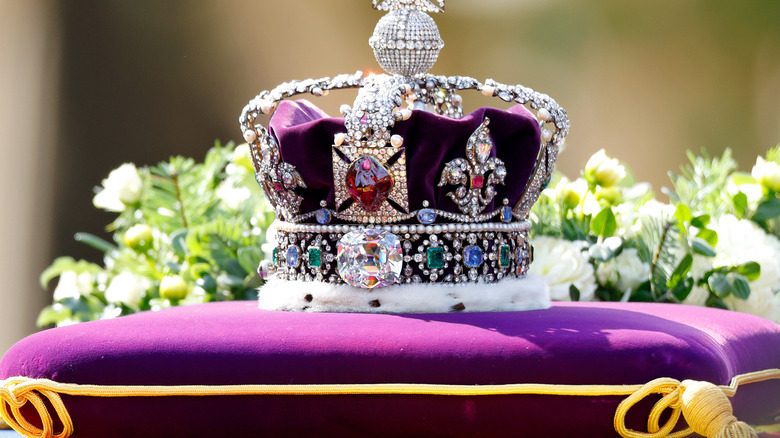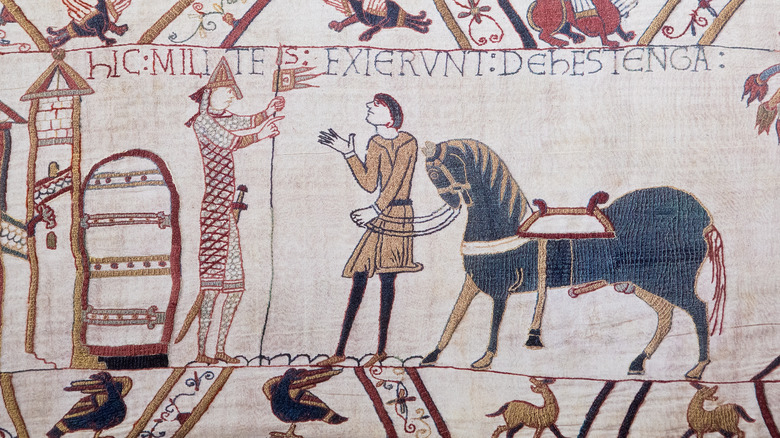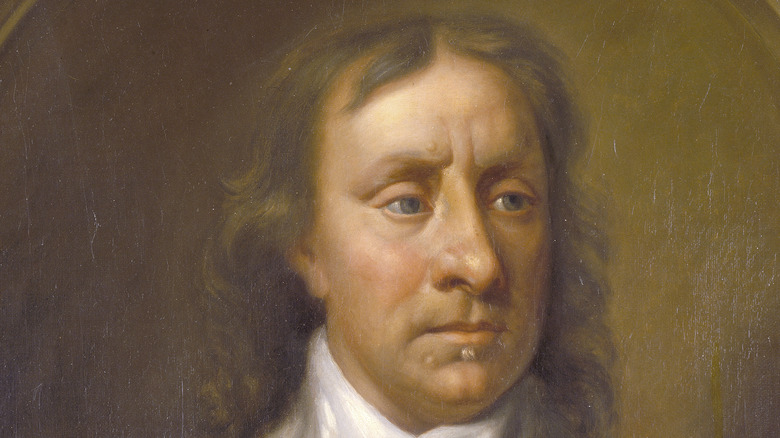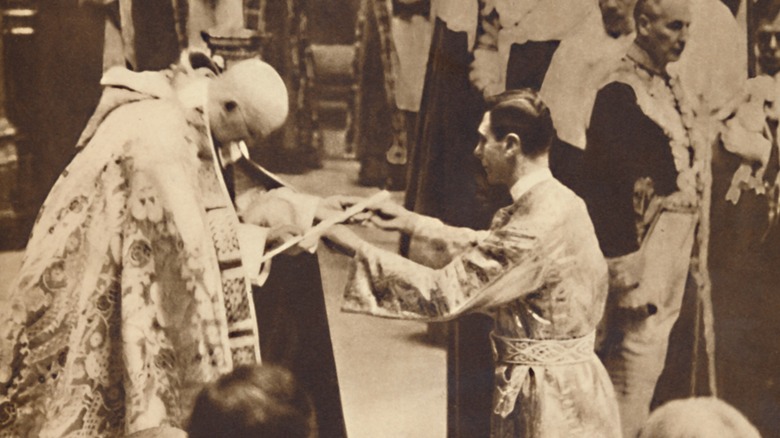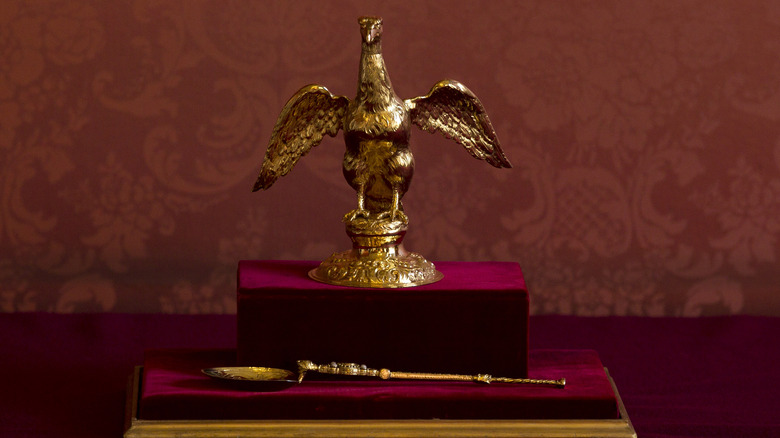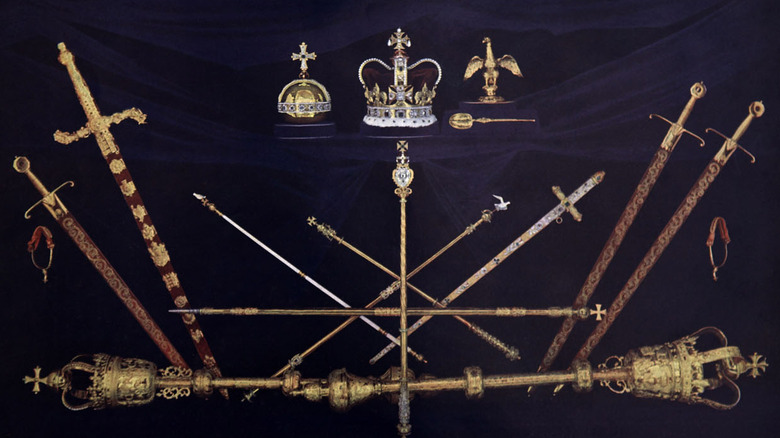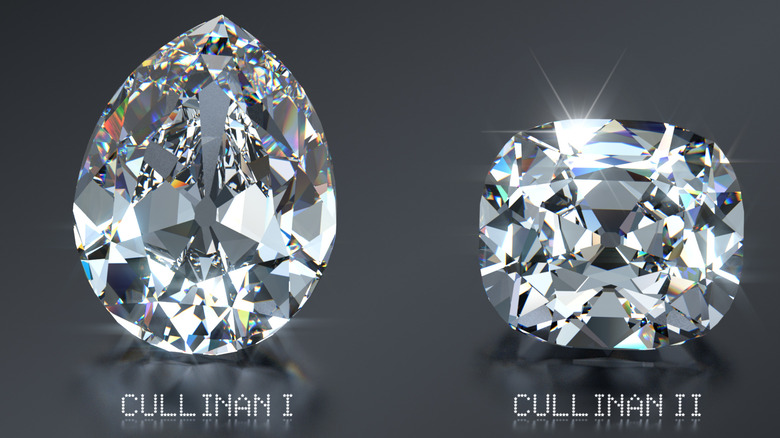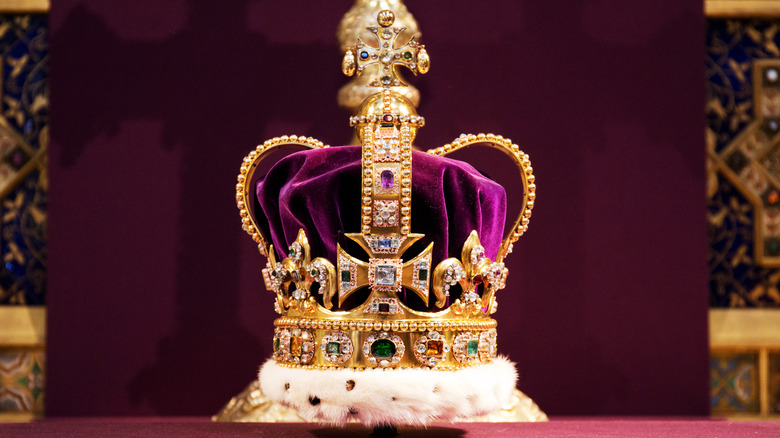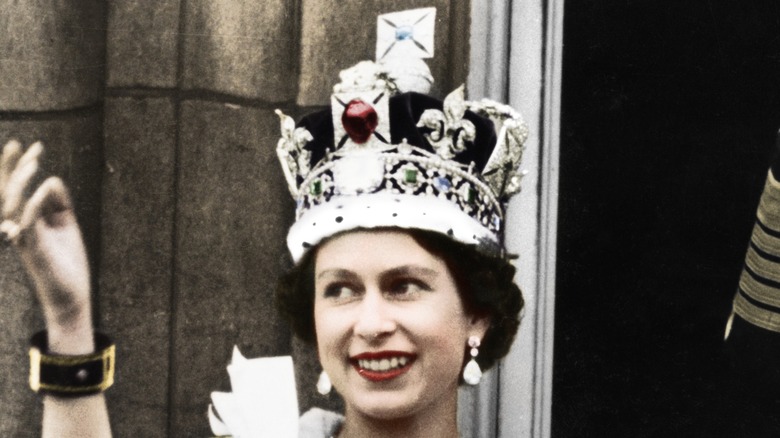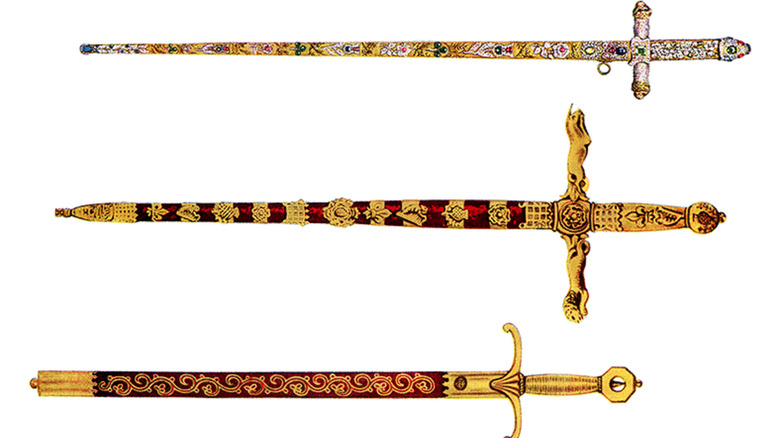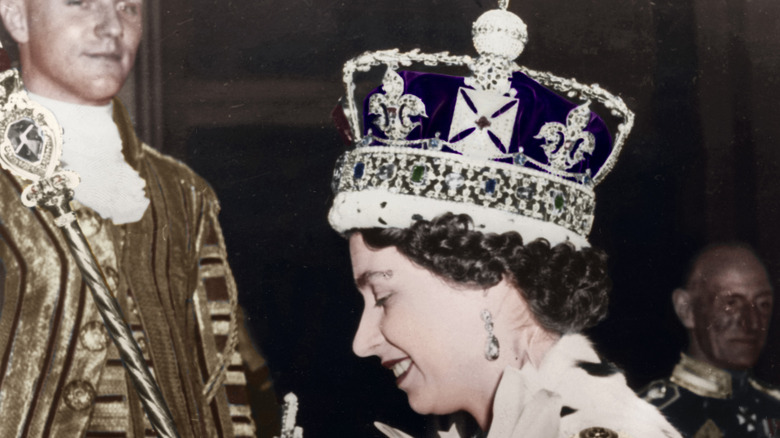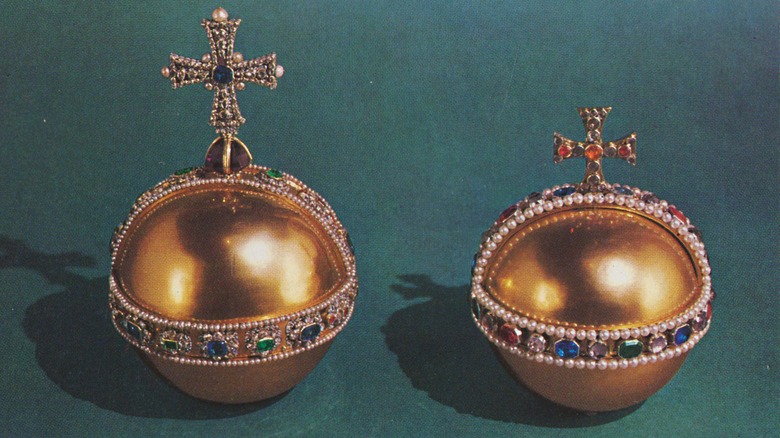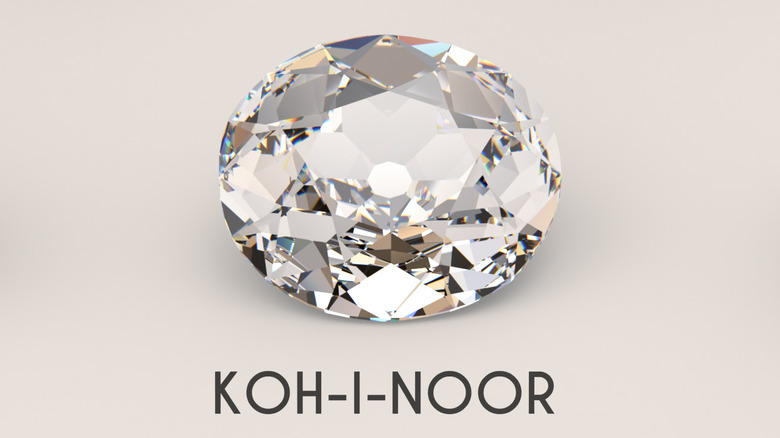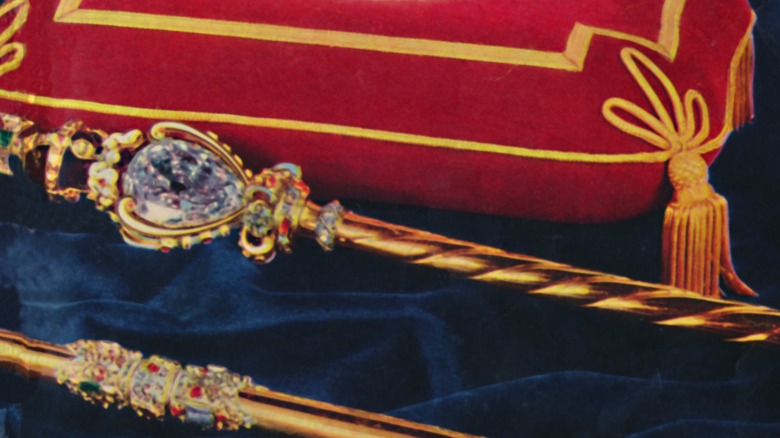The Untold Truth Of The Crown Jewels Of The United Kingdom
Royalty is associated with wealth. The new king of the United Kingdom, Charles III, is no exception. Forbes calculates that he now manages about $42 billion in assets, and plus, he has directly inherited from Queen Elizabeth II some $500 million. Among these assets are the Crown Jewels.
The Crown Jewels are a trove of royal treasure. Historic Royal Palaces details that the collection consists of over 100 items containing more than 23,000 gems. The centerpiece of the Crown Jewels are the coronation regalia consisting of crowns, scepters, vestments, and other symbols of monarchial power and duty. The Crown Jewels are kept safely at the Tower of London where they are guarded by the Yeoman Warders, popularly known as the Beefeaters.
It is hard to place a value on the Crown Jewels because aside from their intrinsic worth from their gold and precious stones, they have great historic value. Forbes mentions that the Royal Institution of Chartered Surveyors pegged their value at $4 billion based on the sale of 1887 French Crown Jewels and the sale of Princess Margaret's jewelry. But really, nobody truly knows how much they could fetch at auction. Let's now look at the fascinating, and often untold, truth about the Crown Jewels of the United Kingdom.
The Crown Jewels were holy relics
The Crown Jewels have their origin in the regalia used to invest medieval English kings with the divine authority to rule. The World History Encyclopedia notes that the early English kings were surely crowned by an archbishop. However, these coronations were simpler affairs in which the incoming king might even prefer to be topped with a fancy helmet and forgo a crown.
The implementation of the elaborate coronation ceremony began with William the Conqueror on Christmas Day, 1066. Fresh from his successful conquest of England, the new king probably wanted to make a point and express his own divine authority. The regalia that was used at the ceremony formed the core of the original Crown Jewels.
The regalia became holy relics. According to "Art, Passion & Power: The Story of the Royal Collection," the regalia was kept at Westminster Abbey whose church had been built for King Edward the Confessor who had been buried there. In the 12th century, Edward was canonized a saint. Thus, all items that had been his or associated with him became relics. For example, the crown which was used in coronations was purported to be St. Edward's Crown.
Many of the original items were destroyed
For several hundred years the coronation regalia of St. Edward was used to empower the British sovereigns. The only major change seems to have occurred in the 13th century. The World History Encyclopedia explains that in 1216, while trying to escape rebel barons, King John lost many of the Crown Jewels in a river as he fled London. The new king, Henry III, required new regalia and had a set made to go with the new shrine he made for St. Edward.
More disastrous for the original Crown Jewels were the English Civil Wars of the 17th century. This conflict, which squared off Parliamentary forces against King Charles I, resulted in the monarch's execution in 1649. The British National Archives tells us that the leader of the Parliamentary forces, Oliver Cromwell, thought that the symbols of the "detestable rule of kings" should be destroyed. Almost all the Crown Jewels were broken up. The gold and silver were melted for coinage and the gems sold off.
However, in 1660 the monarchy was restored under Charles II. Many of the precious stones which had been sold were recovered, and a new set was made in time for the king's crowning in 1661. These are the ones that people can still view today.
They were almost stolen once
The Crown Jewels are naturally a target for would-be thieves. Heck, even the Minions wanted them. However, there has only been one semi-successful attempt to steal the Crown Jewels, and that was by one Colonel Thomas Blood. The World History Encyclopedia explains that in 1671, the roguish Thomas Blood (he called himself colonel), plotted the caper. At that time, the public were allowed to view the jewels at the Tower of London for a fee. King Charles II needed money. Security was not tight. An elderly stewart allowed some visitors to handle the jewels after removing them from a locked cabinet.
Colonel Blood visited the jewels several times disguised as a clergyman. This allowed him to scope out the Tower and rightly conclude that the security was laughable. On May 9, he visited the tower with three accomplices. When the keeper removed the jewels they grabbed him and subdued him. The thieves then stuffed the treasure where they could. Blood beat down the crown to hide it better. One of the accomplices even stuffed the orb down his pants.
However, the alarm was sounded and although they got out of the Tower, they were soon caught. Remarkably, and for reasons that can only be speculated upon, Charles II interviewed and then pardoned Colonel Blood. He even gave the criminal a land grant in Ireland. It is a mystery how this came about since the punishment for the crime would have been death through drawing and quartering.
The oldest jewel is a spoon
If somebody asked you what was the oldest item in the Crown Jewels you might guess that it was some sort of jeweled sword (ala Excalibur) or maybe an ancient jewel. However, as strange as it may sound, the oldest object is a spoon.
Atlas Obscura explains that while the other Crown Jewels were being melted after the abolition of the monarchy in 1640, one Mr. Kynnersley purchased a small golden spoon from the collection for 16 shillings. This spoon, the Coronation Spoon, first appears in the written record in 1349, though it is thought to be as old as the mid-to-late 12th century. Some experts believe that it was originally used to mix water and wine, but starting in 1603 it was used to anoint the monarch with oil. Mr. Kynnersley returned the spoon upon the restoration of the monarchy in 1660.
The spoon is used in tandem with another old artifact, the ampulla. According to the World History Encyclopedia, this eagle-shaped vessel dates from the 14th century and is used to store the holy oil used in the coronation ceremony.
They cannot leave Britain
According to the Crown Estate, the Crown Jewels are owned by the current Sovereign "in right of the Crown." What this means is that they belong to whoever is the current king or queen of the United Kingdom. However, they are not considered personal property and cannot be sold or transferred. For example, King Charles III cannot sell any Crown Jewels if he is short of cash, and nor could have Queen Elizabeth II bequeathed them in her will for anybody she liked. Nor does the monarch see any proceeds from the thousands of tourists who pay to view the Crown Jewels at the Tower of London. This applies equally for most so-called Royal property.
This situation arose during the reign of George III (ruled 1760-1820). The Christian Science Monitor explains that the king donated most royal property to the government which had the benefit of allowing the people to pay for their maintenance. For example, Buckingham Palace is simply on loan to the Windsors. The Crown Jewels are further restricted since, according to "Royal Wills in Britain from 1509 to 2008," by Common Law and tradition, the Crown Jewels are forbidden to leave the country.
Before George III, it seems the monarch could do with the Crown Jewels what he or she wanted. For example, "Gems and Jewels" relates how Henry VI pawned to three people one of the Crown Jewels called the "rich collar" which was dismantled into different pieces. He never got it back.
The largest diamond in the world is in the collection
The Crown Jewels have a lot of bling. In fact, there are 23,578 gemstones in the entire collection (per Historic Royal Palaces), including thousands of diamonds. And of the diamonds, the largest – and indeed the largest in the world – was the Cullinan Diamond.
Britannica tells us this gem was found in South Africa in 1905. The diamond in its rough form was huge, weighing 3,106 carats (about 1.3 pounds). It was named after Sir Thomas Cullinan, who had located the mine some three years earlier.
In 1907, the Cullinan diamond was presented to King Edward VII. It was subsequently cut into 9 large finished diamonds and around 100 smaller stones. All of these flawless gemstones were incorporated into the Crown Jewels. The biggest of the lot is the 530.2-carat Cullinan I, known as the Great Star of Africa. This gem resides in the Sovereign's Sceptre with Cross. The second largest, Cullinan II, is set in the Imperial State Crown.
They feature three crowns
One of the main highlights of the Crown Jewels are the crowns. The "Historical Dictionary of the British Monarchy" tells us that there are three main crowns in the collection which are reserved for the monarch, as well as an assortment of lesser crowns for Princes, Princesses, and consorts.
The most sacred crown, according to Historic Royal Palaces, is St. Edward's Crown. Created in 1661 to replace the old St. Edward's Crown lost during the English Civil Wars, it is used strictly at the time of crowning. Given its solid gold frame, it is quite heavy, weighing almost five pounds. More used is the Imperial State Crown. This crown was created in 1937 and is used at the State Opening of Parliament among other occasions. This might be because it is significantly lighter than St. Edward's Crown weighing, according to the World History Encyclopedia, only 32 ounces.
The third crown is the Imperial Crown of India. This crown has a curious origin since it was specifically made for King George V's appearance at the Delhi Durbar in 1911. This makes it the only crown able to leave the country. According to CNN, the Imperial Crown of India is also the blingiest crown featuring some 6,000 diamonds. It has only been worn once.
The Imperial State Crown has a ruby that is not a ruby
The Imperial State Crown has some of the most historic gems. History Royal Palaces tells us that this crown contains numerous precious stones including four rubies, 11 emeralds, and 17 sapphires. However, the main stone used is diamond. The crown has 2,868 of these stones.
These gems would be valuable in their own right, but some of them have historic significance. For example, the World History Encyclopedia tells us that this crown includes the 317-carat Cullinan II diamond, the 104-carat Stuart Sapphire, and St. Edward's Sapphire. This last gem was said to have come from the ring of St. Edward himself. There is also the so-called Black Prince's Ruby. This gem is, in fact, not a ruby at all but a basel or spinel which is a semiprecious stone. The story is that the stone was given to Edward the Black Prince of Wales by the King of Castile who plundered it from the King of Granada. It also is said that in 1415, King Henry V wore the stone in his helmet at his famous victory at the Battle of Agincourt.
It has a chipped sword
The Crown Jewels also feature medieval weapons of war, specifically swords. "Crown, Orb, and Sceptre" tells us that there are five swords among the Crown Jewels: the Sword of State, Curtana, the Jeweled State Sword, the Sword Spiritual, and the Sword Temporal.
The swords are all used during the coronation ceremony. The Swords Spiritual and Temporal represent spiritual and worldly justice. Curtana, is a sword that is purposefully broken at the end, because it represents mercy. The name comes from a legend about a Danish warrior who was about to kill the son of Charlemagne but at the last moment heard a voice from heaven for him to stop. The warrior's sword was named Courtain, meaning "short sword."
By far the flashiest of the swords is the Jeweled State Sword. This blade was made for George IV's 1821 coronation. The World History Encyclopedia notes that it is also called the Jeweled Sword of Offering and has jewels embedded in the scabbard shaped into the symbols of Ireland, England, and Scotland. Perhaps less fancy but more formidable is the Sword of State which is dated to 1678. This is a two-handed, 32-inch long affair. It is so big it is carried point up when in procession and is swapped out for the lighter Jeweled Sword during service.
They feature a walking stick
By now it is clear that St. Edward is the patron saint of the Crown Jewels. One more object he supposedly had left behind is what "The Crown Jewels of England" identifies as St. Edward's Staff, also called the "Rod of Justice and Equity." This object, which was remade in 1661 to resemble the original which had been melted down, is a gold staff divided into sections with a steel pike at its base.
It is unclear what the original purpose of St. Edward's Staff was. Early records appear saying that the Anglo-Saxon kings used it in their ceremonies. It is sometimes presumed to symbolize a means for guiding the monarch. It also is clear that it was different than the scepters, and it was likely that the monarch held the scepter in one hand and the staff in the other. Another take is from "English Coronation Records," which presumes that back in the day, the monarch would walk with the St. Edward's Staff during the procession.
The Monarchs hold the world in their hands
While all the Crown Jewels are imbibed with some kind of history or symbolism, perhaps none has more meaning than the orbs. "Historical Dictionary of the British Monarchy" explains that there are two orbs: the Small Orb and the Sovereign's Orb.
The Small Orb was made for the coronation of Queen Mary II in 1689 while the Sovereign's Orb was made in 1661 for King Charles II's coronation. Historic Royal Palaces explains how the orbs are presented to the sovereign at the time of investiture. This is when they are given objects to remind them of their duty and place. This is demonstrated by the shape of the orbs and the crosses atop them which symbolize how the power over the world comes from God.
The Sovereign's Orb is a particularly spectacular piece of work. The World History Encyclopedia explains how this hollow gold globe is set with pearls and other precious stones. Beneath its cross is a large amethyst. The Sovereign's Orb has been used at every coronation since 1661. The small orb was used jointly with the Sovereign's Orb at Queen Mary II's investiture since she was simultaneously being crowned with her husband William of Orange as joint monarchs.
Some of the collection is contested
Many of the Crown Jewels saw their origin in parts of the British Empire. In consequence, there is a point of view that some items within the collection are plundered loot.
The greatest example of this is the Koh-i-Noor diamond, also spelled Koh-i-Nûr. Historic Royal Palaces explains that this 105.6-carat diamond originated in the Golconda mines of south-central India. Its turbulent history is detailed by Smithsonian. First, it appears as a jewel upon the bejeweled Peacock Throne of the Mughal Emperor Shah Jahan. In the 18th century it was taken as the spoils of war by the Persians. The diamond would then find itself in Afghanistan where it passed from ruler to ruler through bloodshed until it returned to India in 1813 to Maharaja Ranjit Singh as a gift. The World History Encyclopedia describes how the East India Company muscled into India in the early 19th century. After the Anglo-Sikh Wars from 1845 to 1849, the Koh-i-Noor was specified to be given to Queen Victoria as part of the peace deal. Yet the Queen did not care for the gem, thinking it did not sparkle enough. So it was recut in 1852.
The diamond is said to impart good luck to women and bad to men, so that is why it was placed in the crown of the Queen Mother in 1937. While brilliant in the Crown Jewels, many in India and beyond believe that this gem should return to its original home.
There are two scepters
Every sovereign worth his or her salt must have a scepter, and the British monarchs have two. Both were made in 1661. The first is the Scepter with Dove. This, as "Crown, Orb, and Sceptre" describes, is a rod surmounted by a white dove. The dove itself represents the Holy Ghost, but the chief purpose of the Scepter is to remind sovereigns of their office's importance in spirituality. This scepter is also called the "Rod of Equity and Mercy."
The second scepter is the brilliant Sovereign's Scepter with Cross. This scepter has been used at every coronation. It was remade in 1910 when, as Historic Royal Palaces explains, George V had the immense Cullinan I diamond, sometimes called the Great Star of Africa, added to it. This diamond, like the Koh-i-Noor, carries controversy. CNN reported that since the death of Elizabeth II, some have called for the return of Cullinan I to South Africa, viewing its acquisition by colonial authorities as illegitimate.
